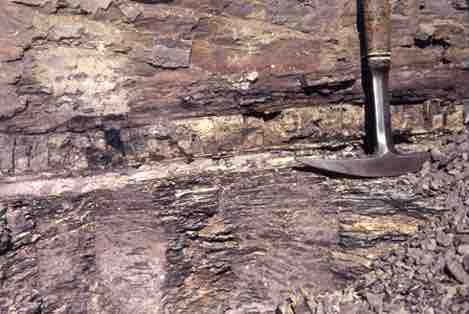Biodiversity Change through Geological Time
The number of species on the planet, or in any geographical area, is the result of an equilibrium of two evolutionary processes that are ongoing: speciation and extinction. Both are natural "birth" and "death" processes of macroevolution. When speciation rates begin to outstrip extinction rates, the number of species will increase; likewise, the number of species will decrease when extinction rates begin to overtake speciation rates. Throughout earth's history, these two processes have fluctuated, sometimes leading to dramatic changes in the number of species on earth .
Fossil record
Extinction occurrences, as reflected in the fossil record, have fluctuated throughout earth's history. Sudden and dramatic losses of biodiversity, called mass extinctions, have occurred five times.
Paleontologists have identified five strata in the fossil record that appear to show sudden and dramatic losses in biodiversity known as mass extinctions. There are many lesser, yet still dramatic, extinction events, but the five mass extinctions have attracted the most research. An argument can be made that the five mass extinctions are only the five most extreme events in a continuous series of large extinction events throughout the Phanerozoic (since 542 million years ago). In most cases, the hypothesized causes are still controversial.
The Five Mass Extinctions
The fossil record of the mass extinctions was the basis for defining periods of geological history, so they typically occur at the transition point between geological periods. The transition in fossils from one period to another reflects the dramatic loss of species and the gradual origin of new species .
Five mass extinctions
The transitions between the five main mass extinctions can be seen in the rock strata. The table shows the time that elapsed between each period.
The Ordovician-Silurian extinction event is the first-recorded mass extinction and the second largest. During this period, about 85 percent of marine species (few species lived outside the oceans) became extinct. The main hypothesis for its cause was a period of glaciation followed by warming. These two extinction events, cooling and warming, were separated by about 1 million years; the climate changes affected temperatures and sea levels. Some researchers have suggested that a gamma-ray burst caused by a nearby supernova is a possible cause of the Ordovician-Silurian extinction. The gamma-ray burst would have stripped away the earth's ozone layer, causing intense ultraviolet radiation from the sun. It may account for climate changes observed at the time.
The late Devonian extinction may have occurred over a relatively long period of time. Its causes are poorly-understood and it appears to have have affected only marine species.
The end-Permian extinction was the largest in the history of life. Estimates predict that 96 percent of all marine species and 70 percent of all terrestrial species were lost.The causes for this mass extinction are not clear, but the leading suspect is extended and widespread volcanic activity that led to a runaway global-warming event. The oceans became largely anoxic, suffocating marine life. Terrestrial tetrapod diversity took 30 million years to recover after the end-Permian extinction. The Permian extinction dramatically altered earth's biodiversity composition and the course of evolution.
The causes of the Triassic–Jurassic extinction event are not clear. Hypotheses of climate change, asteroid impact, and volcanic eruptions have been argued. The extinction event occurred just before the breakup of the supercontinent Pangaea; although, recent scholarship suggests that the extinctions may have occurred more gradually throughout the Triassic.
The causes of the end-Cretaceous extinction event are the ones that are best understood. It was during this extinction event, about 65 million years ago, that the dinosaurs, the dominant vertebrate group for millions of years, disappeared from the planet (with the exception of a theropod clade that gave rise to birds). Indeed, every land animal that weighed more then 25 kg became extinct. The cause of this extinction is now understood to be the result of a cataclysmic impact of a large meteorite or asteroid off the coast of what is now the Yucatán Peninsula. This hypothesis, proposed first in 1980, was a radical explanation based on a sharp spike in the levels of iridium (which rains down from space in meteors at a fairly constant rate, but is otherwise absent on earth's surface) at the rock stratum that marks the boundary between the Cretaceous and Paleogene periods . The Cretaceous-Paleogene (K-Pg) boundary marked the disappearance of the dinosaurs in fossils, as well as many other taxa. The researchers who discovered the iridium spike interpreted it as a rapid influx of iridium from space to the atmosphere (in the form of a large asteroid), rather than a slowing in the deposition of sediments during that period. It was a radical explanation, but the report of an appropriately aged and sized impact crater in 1991 made the hypothesis more credible. Now, an abundance of geological evidence supports the hypothesis. Recovery times for biodiversity after the end-Cretaceous extinction were shorter, in geological time, than for the end-Permian extinction: on the order of 10 million years.

K-Pg mass extinction
In 1980, Luis and Walter Alvarez, Frank Asaro, and Helen Michels discovered, across the world, a spike in the concentration of iridium within the sedimentary layer at the K–Pg boundary. These researchers hypothesized that this iridium spike was caused by an asteroid impact that resulted in the K–Pg mass extinction. In the photo, the iridium layer is the light band.